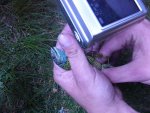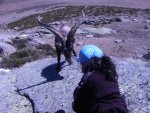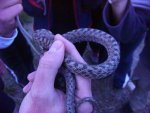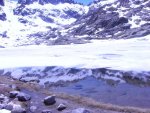Azhael
Site Contributor
- Joined
- May 7, 2007
- Messages
- 6,645
- Reaction score
- 103
- Points
- 0
- Location
- Burgos
- Country
- Spain
- Display Name
- Rodrigo
I went on a 3 day trip to a mountain range in central spain this week, and although the place was gorgeous, i was quite deceived.
First i´ll start by saying the area has been traditionally studied by members of my university, in fact it´s the cradle of both ornythology and herpethology study here in Spain, and lots of tesis have been born there. So, as you can imagine the area has been VERY well studied.
I´m saying this because we were able to compare the observations and hard work of many people through many years with the actual state of amphibian populations. It was heartbreaking.
In a particular small area, there had been records of 300 adult Bufo bufo gredosicola. We only saw 2. Hundreds of S.s.almanzoris had been observed, some even in broad daylight....we saw none, not even larvae.
We only saw the 2 male B.bufo, one single male B.calamita, a female P.perezi and a juvenile R.iberica. We only found eggs from B.calamita. No larvae of any species.
One of our professors had studied the very same area for years and he was noticiably affected by the situation encountered this year.
In another area, close to the mountain range, we visited a bog land which is a special Habitats Directive 1...and therefore is supossed to be swarming with life. We only found one dead T.marmoratus, and heard a couple of Hyla arborea.
No Lissotriton, no Triturus, no Alytes, no Discoglossus, no Pelophyllax, no Salamandra...nothing....
On a happier note we saw plenty of Capra pyrenaica victoriae(impressive beautiful beasts they are), and lots of lizards. Birds were common and we were able to observe several species, with a particular emphasis on Luscinia svecica.
So the trip was great, despite my hurting bones and my falling roasted skin, but it was a smack in the face too. We witnessed amphibian decline with our own eyes and it wasn´t pretty....
Now, some pics of what we saw (my camera run out of bateries in the worst moment...so some things are not pictured).
First pic is the area mentioned above(the one supossed to be full of Bufo).
Second pic is a beautiful male Lacerta schreiberi found alongside a river.
Third pic is an splendid male of C.pyrenaica victoriae. We were told that that particular animal was a golden prize and was already "booked" to be hunted....sad.
Forth pic, a nice male of Luscinia svecica, one of the most stunning little birds i´ve seen.
Fifth pic is a Coronella austriaca we found crossing the road. It was the first alive Coronella i had ever seen, and the biggest too.
Finally, a picture of the big lagoon at the feet of the highest peek of the mountain range, it was beautiful, and the water was so cold it hurt after just two seconds. Mind you my feet hurt so much from the walking and the climbing that i went straight into the water. Dawn, you´ll like this, the laggon is visited by several otters during the summer months.
I´m sorry i have no pictures of any caudates or anurans...our finds were very limited and my camera had run out of batteries. If my classmates send me some pics of the anurans we saw, i´ll post them.
First i´ll start by saying the area has been traditionally studied by members of my university, in fact it´s the cradle of both ornythology and herpethology study here in Spain, and lots of tesis have been born there. So, as you can imagine the area has been VERY well studied.
I´m saying this because we were able to compare the observations and hard work of many people through many years with the actual state of amphibian populations. It was heartbreaking.
In a particular small area, there had been records of 300 adult Bufo bufo gredosicola. We only saw 2. Hundreds of S.s.almanzoris had been observed, some even in broad daylight....we saw none, not even larvae.
We only saw the 2 male B.bufo, one single male B.calamita, a female P.perezi and a juvenile R.iberica. We only found eggs from B.calamita. No larvae of any species.
One of our professors had studied the very same area for years and he was noticiably affected by the situation encountered this year.
In another area, close to the mountain range, we visited a bog land which is a special Habitats Directive 1...and therefore is supossed to be swarming with life. We only found one dead T.marmoratus, and heard a couple of Hyla arborea.
No Lissotriton, no Triturus, no Alytes, no Discoglossus, no Pelophyllax, no Salamandra...nothing....
On a happier note we saw plenty of Capra pyrenaica victoriae(impressive beautiful beasts they are), and lots of lizards. Birds were common and we were able to observe several species, with a particular emphasis on Luscinia svecica.
So the trip was great, despite my hurting bones and my falling roasted skin, but it was a smack in the face too. We witnessed amphibian decline with our own eyes and it wasn´t pretty....
Now, some pics of what we saw (my camera run out of bateries in the worst moment...so some things are not pictured).
First pic is the area mentioned above(the one supossed to be full of Bufo).
Second pic is a beautiful male Lacerta schreiberi found alongside a river.
Third pic is an splendid male of C.pyrenaica victoriae. We were told that that particular animal was a golden prize and was already "booked" to be hunted....sad.
Forth pic, a nice male of Luscinia svecica, one of the most stunning little birds i´ve seen.
Fifth pic is a Coronella austriaca we found crossing the road. It was the first alive Coronella i had ever seen, and the biggest too.
Finally, a picture of the big lagoon at the feet of the highest peek of the mountain range, it was beautiful, and the water was so cold it hurt after just two seconds. Mind you my feet hurt so much from the walking and the climbing that i went straight into the water. Dawn, you´ll like this, the laggon is visited by several otters during the summer months.
I´m sorry i have no pictures of any caudates or anurans...our finds were very limited and my camera had run out of batteries. If my classmates send me some pics of the anurans we saw, i´ll post them.






